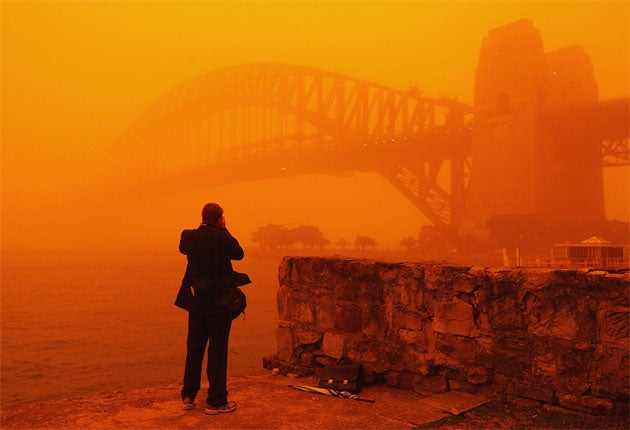Q.What's black as night and red all over? A. Sydney

Your support helps us to tell the story
From reproductive rights to climate change to Big Tech, The Independent is on the ground when the story is developing. Whether it's investigating the financials of Elon Musk's pro-Trump PAC or producing our latest documentary, 'The A Word', which shines a light on the American women fighting for reproductive rights, we know how important it is to parse out the facts from the messaging.
At such a critical moment in US history, we need reporters on the ground. Your donation allows us to keep sending journalists to speak to both sides of the story.
The Independent is trusted by Americans across the entire political spectrum. And unlike many other quality news outlets, we choose not to lock Americans out of our reporting and analysis with paywalls. We believe quality journalism should be available to everyone, paid for by those who can afford it.
Your support makes all the difference.Sydney awoke yesterday to an eerie sight: a blood-orange dawn and a city bathed in red light. A thick dust cloud hung over the urban sprawl, with the red dirt of the outback – transported nearly 1,000 miles by winds so strong they blew birds out of the trees – blanketing pavements, buildings and beaches.
The worst dust storm for 75 years caused chaos in Sydney, with the country's biggest airport virtually shut down because of poor visibility. International flights were diverted, and domestic air traffic was disrupted. Ferries on the harbour were suspended. Tourists visiting the Sydney Opera House found its white sails had turned orange, while the Harbour Bridge was visible only in silhouette.
The elderly, the sick and the asthmatic were urged to stay indoors, amid the worst air pollution ever recorded. Many people who ventured out wore face masks, with the usually laid- back city resembling Hong Kong during the bird flu scare. Commuters wrapped their faces in scarves or pressed handkerchiefs to their mouths as they hurried on to buses and trains, coughing and spluttering.
Wild winds had whipped up millions of tonnes of topsoil from the drought-parched Australian interior and carried it eastwards. The mining town of Broken Hill, 700 miles west of Sydney, was completely blacked out by swirling dust, and a zinc mine had to close. The winds, gusting at more than 60mph, also fanned bushfires in New South Wales. "This is unprecedented," said Richard Whitaker, a senior meteorologist at Australia's television Weather Channel. "We are seeing earth, wind and fire together."
While dust storms are not uncommon in the outback, they rarely travel as far as coastal areas. The Bureau of Metereology described yesterday's storm, which affected Queensland as well as New South Wales, as "extremely rare". The bureau's NSW regional director, Barry Hanstrum, said: "It's one of the worst, if not the worst."
On waking to the dramatic red skies, with dawn sunlight struggling to penetrate the thick dust, some Sydneysiders thought a major bushfire was heading their way. Others feared the end of the world was nigh. One resident, identified only as Karen, told ABC radio: "It did feel like Armageddon because when I was in the kitchen, looking out the skylight, there was this red glow coming through."
Later, rain fell as mud over inland areas. After a 15-minute walk through my Sydney neighbourhood, I fled back home, coughing uncontrollably, my eyes stinging. The washing on the line in my backyard was bone-dry, but coated with grit.
Join our commenting forum
Join thought-provoking conversations, follow other Independent readers and see their replies
Comments